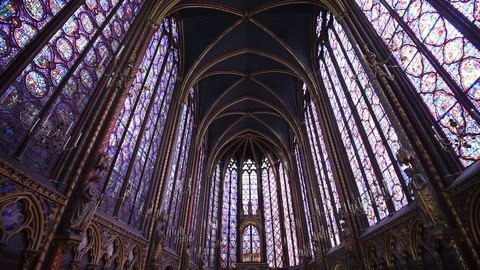
Last updated 9/2018
MP4 | Video: h264, 1280x720 | Audio: AAC, 44.1 KHz
Language: English | Size: 1.50 GB | Duration: 1h 9m
Let there be light!
What you'll learn
Students will learn the key developments, vocabulary terms, and works of art which are associated with Gothic architecture.
Students will be able to recognize major Gothic cathedrals and their features.
Students will gain an appreciation of the engineering advances that contributed to the success of Gothic architecture.
A comprehensive vocabulary list is found at the end of the course.
Requirements
Students who have completed the preceding course "Essentials of Romanesque Art & Architecture" will be able to appreciate some elements' continuity, but this course also can stand alone and provide a solid grounding in Gothic architecture.
Description
In many ways, Gothic engineers were making what had seemed impossible the norm. On one hand, the solid stone walls had been stretched into arches at their bases and punctured by oculi, clerestories, and stained-glass windows virtually their entire length and breadth. At the same time, weight was being piled onto the ceiling vaults; the decorative vaulting only added even more weight to the gravity-defying cut-stone vaultwork. As many Medieval builders discovered, you could not eliminate most of the surface area of a supporting wall while at the same time constructing massively heavily loads above; the strain proved simply too much for the upper levels to bear, weakened as they were by the ubiquitous presence of stained glass (which we will get to shortly). So, a novel innovation appeared which becomes one of the hallmarks of the Gothic style: the flying buttress. These were exterior supports which had their base in the low, sturdy walls of the church's side aisles and outer chapels, but they reached up to where they were most needed. The style of architecture which came to dominate the capitals of Medieval Europe was rooted in a new religious, philosophical, and even proto-scientific concept of the nature of light. For the first time, the stone walls of heavy Romanesque churches gave way to expanses of colored glass which bathed interiors in the sacred rays Medieval scholastic churchmen had been exploring. Hand in hand with the new appreciation of light came the prerogative to stretch sacred spaces as high as their engineering permitted - the higher the nave, the closer to God. These and other characteristics of the Gothic architectural style make up the content of this course.
Overview
Section 1: Introduction
Lecture 1 What Exactly Do We Mean By "Gothic"?
Section 2: The Cathedral: New Form and Function
Lecture 2 Distinctive Features of the Gothic Cathedral
Lecture 3 Let There Be Light
Section 3: Different Gothic Styles
Lecture 4 Paris, Intellectual Capital of Medieval Europe
Lecture 5 Beyond France: English, German, and Italian Gothic Architecture
High school, university, and graduate students will find both a review of key pieces and developments as well as original research and connections which are exclusive to this course.
Homepage
https://www.udemy.com/course/essentials-of-gothic-architecture/
https://rapidgator.net/file/b2944fc4d6c7808036aba21409558e7e/llfjm.Essentials.Of.Gothic.Architecture.part1.rar.html
https://rapidgator.net/file/c549d6854bbeb6580f3d888a9951f9ee/llfjm.Essentials.Of.Gothic.Architecture.part2.rar.html

https://uploadgig.com/file/download/596db077b4d80509/llfjm.Essentials.Of.Gothic.Architecture.part1.rar
https://uploadgig.com/file/download/ec6ACc6C7e522d48/llfjm.Essentials.Of.Gothic.Architecture.part2.rar

https://nitroflare.com/view/53EF2C8886A79FC/llfjm.Essentials.Of.Gothic.Architecture.part1.rar
https://nitroflare.com/view/1EC089D6304CC7E/llfjm.Essentials.Of.Gothic.Architecture.part2.rar
